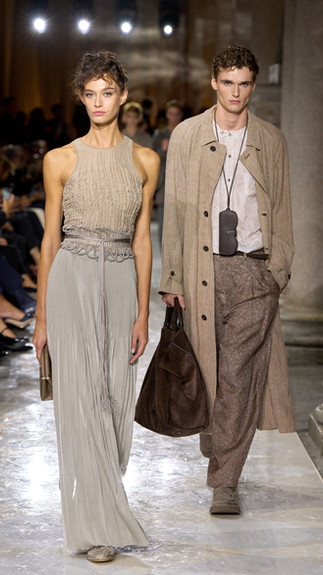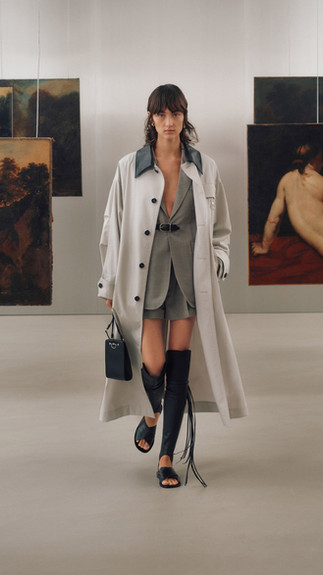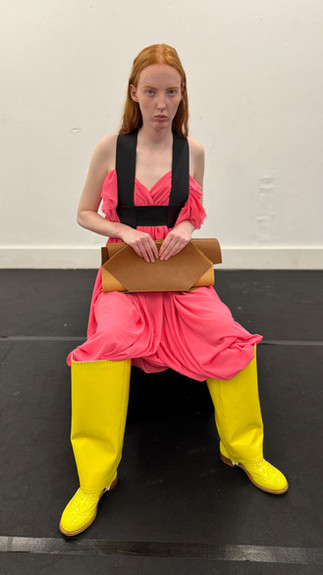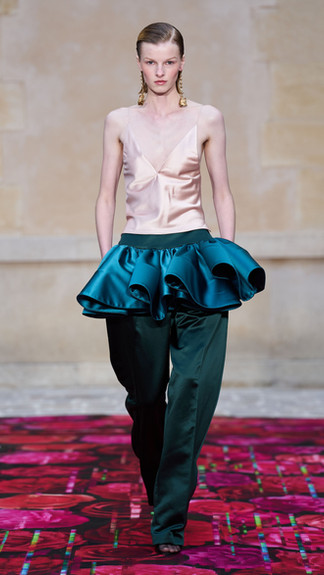The 7 Defining Trends from Fashion Month: Milan and Beyond
- BY SASHA-LEIGH HODGEN

- Oct 6
- 4 min read

Fashion month has always been more than just a calendar event—it’s a mirror of culture, mood, and the shifting priorities of style. The latest shows across Milan, London, New York, and Paris reflected a duality: on one side, a craving for timeless pieces rooted in craft, and on the other, a fearless embrace of fantasy, colour, and nostalgia. This season’s runways offered us both stability and drama, the understated and the theatrical. From the crisp minimalism of neutral tailoring to the grandeur of regal gowns, here are the 7 trends that shaped the season.
1. Men’s Shirting
The simplicity of men’s shirting emerged as one of Milan’s most powerful statements. The Attico, Moschino, TOD’s, Missoni, Bottega Veneta, and Dolce & Gabbana all reinterpreted the humble button-down with elevated precision. Loose and slightly undone at The Attico gave it a louche sensuality, while Missoni infused theirs with pattern play and soft draping.
Dolce & Gabbana, ever masters of Italian seduction, worked the shirt into romantic silhouettes, transforming tailoring into a symbol of allure. Across the board, this was a move toward pieces that feel borrowed yet tailored to the wearer, versatile enough to transcend categories of work, leisure, and evening wear.
2. Woven Bags
Accessories made their mark this season, and none more so than the woven bag. Long associated with Bottega Veneta’s mastery, the style reigned supreme with fresh updates. Fendi introduced oversized woven totes that balanced practicality with statement-making presence.
Giorgio Armani kept the aesthetic clean and architectural, while Ferragamo leaned into leather textures with artisanal weaving that felt almost sculptural. Loro Piana’s offering was softer and more casual, a nod to easy elegance. Whether tightly structured or more organic and freeform, the woven bag signalled a return to craft, an accessory trend where tradition and innovation coexist.
3. Trench Coats
The trench coat, that perennial staple, reappeared with renewed force across Milan’s runways. TOD’s and Bottega Veneta leaned into their heritage with tailored precision, while Max Mara, always a champion of outerwear, redefined the trench in an artsy approach, using ruffled sleeves in a cinematic way.
Moschino, true to form, injected wit and whimsy into its version, while The Attico leaned into sharper silhouettes, turning the trench into something sleek and almost architectural. It was a reminder of the trench’s adaptability, it can be uniform, armour, or statement, depending on the designer’s hand.
4. Regal Opulence
If Milan delivered grounded practicality, London and New York pushed us into a world of fantasy. Designers such as Erdem, Richard Quinn, Dilara Findikoglu, Wiederhoeft, and Carolina Herrera embraced a regal aesthetic that transported audiences into another era. Erdem’s Victorian florals and voluminous skirts nodded to royal portraiture, while Richard Quinn dazzled with ornate gowns fit for a modern-day monarch.
Wiederhoeft, meanwhile, blurred fantasy and reality with theatrical drama, his silhouettes dancing between the couture stage and performance art. Carolina Herrera brought the polished refinement she is known for, delivering gowns with aristocratic grace. This “regal” trend spoke to our collective craving for escapism, reminding us that fashion can transport us beyond the ordinary.
5. Neutral Colouring
Amidst the extravagance, there was serenity. Designers like Armarium, Giorgio Armani, Durazzi, and Luisa Spagnoli leaned into neutral tones; beige, ivory, camel, and soft grey, to create a collection that was timeless .
Giorgio Armani’s palette was particularly striking in its restraint, showcasing his decades-long commitment to elegance rooted in quiet power. Armarium and Durazzi embraced minimalism with monochrome layering, while Luisa Spagnoli softened the aesthetic with feminine cuts. These tonal looks provided balance against louder trends, proof that understatement carries just as much weight as spectacle.
6. Colour Blocking
In stark contrast, colour blocking took on new vibrancy across several runways. Aletta, Ferragamo, Burc Akyol, and Cynthia Rowley pieced together bold hues in unexpected combinations. Ferragamo explored bright tones, layering vibrant yellows with chocolate browns, while Cynthia Rowley leaned into punchy primaries, giving her collections youthful energy.
Aletta’s version had a graphic sharpness, turning garments into wearable canvases, while Burc Akyol opted for fluid fabrics that let the colours move with the body. This wasn’t just colour for its own sake; it was strategic, architectural and often sculptural, a reminder that boldness can also be intelligent.
7. 90s Aesthetic
Finally, the decade that refuses to fade: the 90s. Saint Laurent, Vaquera, and Anna Sui mined the archive of minimalism, grunge, and nonchalant cool. Saint Laurent’s pencil skirts and razor-sharp tailoring recalled the decade’s nightlife icons, while Vaquera twisted the aesthetic with raw, deconstructed layering.
Anna Sui leaned into nostalgia with playful prints and accessories, balancing irreverence with femininity. It was less about literal revival and more about tapping into a mood, the effortlessness, the attitude, the sense that clothing should never try too hard yet always leave an impression.
This season, fashion oscillated between two extremes: the pared-back and the extravagant, the everyday and the regal, the neutral and the neon. Milan’s refined pragmatism sat comfortably alongside London’s flamboyant drama, Paris’s edge, and New York’s eclectic spirit. Together, they painted a picture of fashion as multifaceted as the world it reflects. Whether through the grounding calm of neutral palettes or the exuberant fantasy of gowns fit for royalty, the message was clear: fashion today is about duality, and the beauty lies in its contrasts.
























































































































